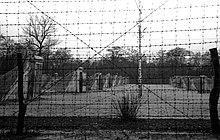Syrez concentration camp
The concentration camp Syrez or Syrezkyj was set up in 1942 on the northern edge of the city of Kiev , only a few hundred meters from Babyn Yar (Russian: Babi Yar ), as a sub-camp of the Sachsenhausen concentration camp . It held about 3,000 prisoners. Camp leader was SS-Sturmbannführer Paul Radomski (also Radomsky ).
At the suggestion of the commissioner to set up a Ukrainian criminal police and the head of divisions IV and V of the commander of the security police and the SD (KdS) in Kiev, Hans Schumacher , the KdS Erich Ehrlinger set up a concentration camp for the opponents of National Socialism (primarily Jews) on the north-western edge of the city of Kiev, today a suburb. From this point on, there were two options for either executing or releasing the prisoners, as well as being sent to the concentration camp. However, only strong craftsmen who did not have a family were sent there; all other Jews were still shot or gassed ( gas vans ). The prisoners (women and men) were housed in caves in the earth. Most of them were malnourished, some starved to death. Radomski led a regiment of terror in the camp. For the slightest misconduct he invented the most severe harassment and often beat the prisoners with the whip.
After the Kiev death game on August 9, 1942, eight football players from the officially dissolved Dynamo Kiev club were interned there. Three of them were shot dead in a mass execution on Radomski's orders in February 1943.
1943 were under special campaign in 1005 to cover up mass murder 327 prisoners as forced laborers used to the bodies of the massacre of Babi Yar "to duck rden " allegedly 40000-45000 people and burn them on pyres, which were piled with gasoline-soaked railroad ties. Afterwards, the forced laborers were shot dead by the security police and SD task forces . Some escaped and reported on these crimes after the war.
Web links
Individual evidence
- ↑ Erhard Roy Wiehn (ed.), Babij Jar 1941 - Commemorating the massacre of German execution squads on the Jewish population of Kiev 60 years later . Hartung-Gorre Publishing House. Constance 2001.
- ↑ See Ray Brandon, Wendy Lower, The Shoah in Ukraine: history, testimony, memorialization , Indiana University Press 2008.
- ↑ spiegel.de June 15, 2012; Volodymyr Prystajko: Tschi buw "mattsch smerti"? Documenty swidtschat. Kyiv 2006, pp. 101, 160.
- ↑ Babyn Jar on Deathcamp.org, accessed January 17, 2015.
- ^ Processes / Sonderkommando 1005 Spiegel, September 30, 1968, accessed on January 23, 2015.
Coordinates: 50 ° 28 ′ 16.9 ″ N , 30 ° 26 ′ 57.9 ″ E

